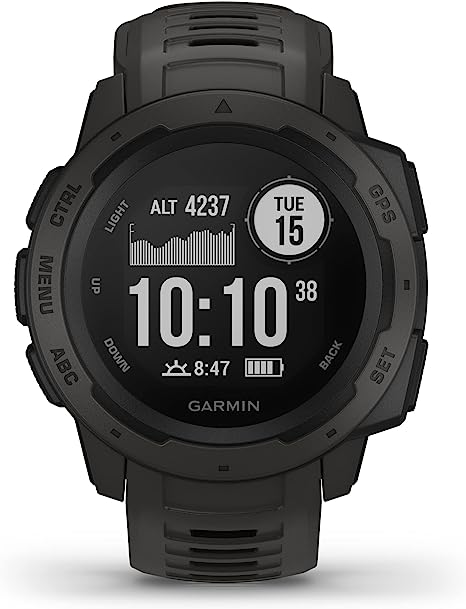Training for a marathon can be a challenging and rewarding endeavor. Whether you’re a beginner or an experienced runner, proper preparation is key to ensure a successful race day. In this article, we will provide you with a comprehensive guide on how to train for a marathon. From setting goals to incorporating cross-training and recovery techniques, we will cover all the essential aspects to help you reach the finish line.
1. Introduction
Training for a marathon requires commitment, discipline, and a well-structured plan. Whether you’re a seasoned runner or new to the sport, the right approach is crucial for achieving your goals and staying injury-free. This article will guide you through the essential steps of marathon training, providing you with valuable insights and tips along the way.

Garmin Instinct, Rugged Outdoor Watch with GPS, Features Glonass and Galileo, Heart Rate Monitoring and 3-Axis Compass, Graphite
2. Setting Your Goals
Before you start training, it’s important to set realistic and specific goals for your marathon. Determine your target finish time, consider your current fitness level, and outline the milestones you want to achieve throughout your training journey. Setting goals provides you with a clear direction and helps you stay motivated during the training process.
When setting your goals, it’s important to take into account factors such as your previous running experience, your available training time, and your overall fitness level. This will help you establish realistic expectations and create a training plan that is tailored to your individual needs.
3. Designing a Training Plan
A well-designed training plan is the foundation of successful marathon preparation. It should include a progressive increase in mileage, incorporate different types of runs, and allow for sufficient recovery periods. Consult with an experienced running coach or use online resources to create a personalized training plan that suits your fitness level and schedule.
Your training plan should include a mix of easy runs, long runs, tempo runs, and speed workouts. Easy runs are done at a comfortable pace to build endurance and promote recovery. Long runs gradually increase in distance to prepare your body for the marathon distance. Tempo runs are performed at a challenging pace, just below your race pace, to improve your lactate threshold and increase your overall speed. Speed workouts, such as intervals and fartleks, involve short bursts of high-intensity running followed by periods of rest or easy running.
4. Building Your Endurance
Endurance is a key factor in marathon running. Gradually increase your weekly mileage, focusing on long runs to build both physical and mental stamina. Start with shorter distances and gradually work your way up, ensuring that you give your body enough time to adapt to the increased demands of running. Aim for incremental improvements and don’t forget to listen to your body to avoid overtraining and injuries.
To build endurance effectively, it’s important to follow a structured progression in your training. Increase your weekly mileage by no more than 10% each week to allow your body to adapt and recover. Additionally, incorporate cross-training activities such as cycling or swimming to supplement your running and provide low-impact cardiovascular exercise.

Adidas Men’s Marathon Jacket 3-Stripes
5. Incorporating Speed and Interval Training
To improve your race pace and overall performance, include speed workouts and interval training in your training plan. These workouts help increase your cardiovascular fitness, build leg strength, and enhance your body’s ability to tolerate and clear lactic acid. Incorporate tempo runs, fartlek runs, and track workouts into your training schedule to challenge your body and improve your speed.
Tempo runs are an effective way to improve your lactate threshold, which is the point at which lactic acid begins to accumulate in your muscles. By running at a comfortably hard pace for a sustained period, you can push your lactate threshold higher, allowing you to run faster without fatiguing as quickly. Fartlek runs, on the other hand, involve alternating periods of faster running with periods of recovery at a slower pace. These runs are less structured than tempo runs and can be customized to fit your preferences and the terrain you’re running on.
Track workouts, such as interval training, can also be incorporated into your training plan. Interval training involves running at a high intensity for a specific distance or time, followed by a recovery period. This type of training helps improve your speed, anaerobic fitness, and running economy. By alternating between fast and slow intervals, you challenge your body to adapt and become more efficient at sustaining faster paces.
6. Cross-Training for Enhanced Performance
Incorporating cross-training activities such as cycling, swimming, or strength training can benefit your overall fitness and reduce the risk of overuse injuries. Engaging in low-impact exercises on your rest days can help you maintain your fitness level while giving your running muscles a break.
Cross-training activities provide a variety of benefits for marathon runners. Cycling and swimming are excellent forms of cardiovascular exercise that help improve endurance and aerobic fitness without putting excessive strain on your joints. Strength training, on the other hand, helps build muscle strength and power, which can enhance your running economy and reduce the risk of injury.
When incorporating cross-training into your marathon training, aim for two to three sessions per week on non-running days. Focus on activities that complement your running, such as cycling or swimming, and include exercises that target the muscles used in running, such as squats, lunges, and core exercises.

AiRunTech Hydration Running Belt with Bottles Zero Bounce Design for Running, Triathlon, Ironman, Marathon, 10K, 5K, Trail Fit for Most Smartphones
7. Proper Nutrition and Hydration
Fueling your body with the right nutrients is vital for optimal performance. Consume a balanced diet rich in carbohydrates, proteins, and healthy fats. Stay hydrated throughout your training, both during runs and in your daily life.
Nutrition plays a crucial role in marathon training, providing the energy and nutrients your body needs to perform at its best. Prioritize complex carbohydrates, such as whole grains, fruits, and vegetables, as they provide sustained energy for your long runs and recovery. Include lean proteins, such as chicken, fish, and legumes, to support muscle repair and growth. Healthy fats, found in foods like avocados, nuts, and olive oil, are also important for overall health and energy production.
Hydration is equally important during marathon training. Aim to drink enough water throughout the day to stay properly hydrated. During long runs, consider carrying a water bottle or planning routes that have water fountains available. Additionally, for runs lasting longer than 60-90 minutes, consider using sports drinks or gels to replenish electrolytes and provide additional carbohydrates.
8. Rest and Recovery
Rest and recovery are crucial components of marathon training. Allow your body time to repair and adapt to the physical demands of running. Incorporate rest days into your training plan, prioritize sleep, and consider techniques like foam rolling, stretching, and massage therapy to aid recovery.
Rest days are just as important as your training days. They give your body the opportunity to recover and rebuild, reducing the risk of overuse injuries. It’s essential to listen to your body and recognize the signs of fatigue or overtraining. If you feel excessively tired, sore, or notice a decline in performance, it’s crucial to take a rest day or modify your training schedule accordingly.
In addition to rest days, prioritize sleep to support your body’s recovery processes. Aim for 7-9 hours of quality sleep each night to allow your muscles to repair and your immune system to strengthen. Incorporating relaxation techniques such as yoga or meditation can also promote mental and physical recovery.
9. Avoiding Injuries
Injury prevention should be a top priority during marathon training. Gradually increase your mileage, listen to your body’s signals, and address any discomfort or pain promptly. Strengthening your muscles, wearing proper footwear, and practicing good running form can all help reduce the risk of injuries.
One of the most common causes of running injuries is overuse. To avoid overuse injuries, it’s essential to gradually increase your mileage and allow your body time to adapt to the increased demands of running. Avoid making sudden increases in mileage or intensity, as this can overload your muscles and joints.
Additionally, incorporating strength training exercises into your routine can help prevent injuries. Focus on exercises that target the muscles used in running, such as your core, hips, and lower body. Building strength in these areas can improve your running form, reduce imbalances, and enhance your overall stability and power.
Choosing the right footwear is also crucial for injury prevention. Visit a specialty running store to get fitted for shoes that suit your running style and provide adequate support and cushioning. Replace your shoes regularly, as worn-out shoes can increase the risk of injuries.

[Voted No.1 Hydration Belt] Runtasty Winners’ Running Fuel Belt – Includes accessories: 2 BPA Free Water Bottles & Runners Ebook – Fits Any iPhone – w/Touchscreen cover – No Bounce Fit and more!
10. Mental Preparation
Marathon running requires mental fortitude. Practice visualization techniques, positive self-talk, and mindfulness exercises to strengthen your mental resilience. Set realistic expectations, focus on the process rather than just the outcome, and develop strategies to overcome challenges during the race.
Mental preparation is just as important as physical training when it comes to marathon running. Long-distance races can be mentally challenging, and developing strategies to overcome negative thoughts and doubts can make a significant difference in your performance.
Visualization techniques involve creating mental images of successfully completing your race, visualizing yourself crossing the finish line, and feeling a sense of accomplishment. This technique helps build confidence and reinforces positive beliefs about your abilities.
Positive self-talk involves using affirmations and encouraging statements to counteract negative thoughts. Replace self-doubt and criticism with positive statements such as “I am strong” or “I can do this.” This practice can help boost your confidence and maintain a positive mindset throughout the race.
Mindfulness exercises, such as deep breathing and meditation, can help you stay present and focused during your training and on race day. These techniques help reduce stress and anxiety and promote a sense of calmness and mental clarity.
11. The Final Weeks of Training
As race day approaches, tapering becomes essential. Reduce your mileage gradually to allow your body to recover fully and store energy for the marathon. Focus on maintaining your fitness level, getting enough sleep, and managing any pre-race jitters.
Tapering is a crucial phase in marathon training, typically lasting two to three weeks before the race. It involves reducing your mileage and intensity to allow your body to recover and repair any accumulated fatigue while maintaining your fitness level.
During the tapering period, gradually decrease your weekly mileage by about 20-30%, but maintain the intensity of your workouts. This allows your muscles to fully recover while keeping your cardiovascular fitness sharp. Use this time to focus on other aspects of your training, such as flexibility exercises and mental preparation.
Getting enough sleep is essential during the final weeks of training. Aim for 7-9 hours of quality sleep each night to ensure optimal recovery and performance on race day. Prioritize relaxation and stress management techniques to stay calm and focused.
Pre-race jitters are normal, and it’s important to manage them effectively. Stick to your training plan and trust in your preparation. Visualize yourself successfully completing the race and remind yourself of the hard work and dedication you’ve put into your training. Surround yourself with a supportive network of friends and family who can help calm your nerves and provide encouragement.
12. Race Day Strategies
On race day, stick to your pre-planned strategies. Start at a comfortable pace, stay hydrated and fueled throughout the race, and adjust your effort based on the course and weather conditions. Break the race into smaller segments to stay motivated and maintain a positive mindset.
Race day is the culmination of your training journey. It’s essential to stick to your pre-race strategies and trust in the training you’ve done. Start the race at a comfortable pace that allows you to settle into a rhythm without exerting excessive effort.
Maintaining proper hydration and nutrition during the race is crucial. Drink water or sports drinks at regular intervals to stay hydrated, and consume energy gels or snacks as needed to replenish carbohydrates and electrolytes. Practice your race-day fueling strategy during your long training runs to ensure it works well for you.
As you progress through the race, be mindful of the course and weather conditions. Adjust your effort level accordingly, taking into account any inclines, declines, or changes in terrain. Breaking the race into smaller segments can help you stay motivated and mentally focused. Focus on reaching each milestone, whether it’s a specific mile marker or a landmark on the course, and celebrate your progress along the way.
Maintaining a positive mindset is crucial during the race. Acknowledge any discomfort or fatigue but remain focused on your goals and the joy of running. Draw inspiration from the energy of the crowd and fellow runners, and remind yourself of the incredible accomplishment you’re working towards.

TLRUN Men’s Running Shorts 5 inch Ultra Lightweight with 5 Pockets Quick Dry Marathon Athletic Run Shorts Linerless
13. Conclusion
Training for a marathon requires dedication, perseverance, and a well-rounded approach. By following a structured training plan, taking care of your body, and nurturing your mental resilience, you can cross the finish line with a sense of accomplishment and pride. Remember to listen to your body, set realistic goals, and enjoy the journey towards achieving your marathon dreams.
14. FAQs
Q1. How long does it take to train for a marathon?
The duration of marathon training varies depending on your fitness level and the specific training plan you follow. Generally, training programs range from 12 to 20 weeks.
Q2. Should I run every day during marathon training?
No, it’s important to incorporate rest days into your training plan. Rest days allow your body to recover and reduce the risk of overuse injuries. Listen to your body and adjust your training schedule accordingly.
Q3. Do I need to follow a strict diet during marathon training?
While a balanced diet is important, it’s not necessary to follow a strict or rigid diet. Focus on consuming nutritious foods, stay hydrated, and fuel your body appropriately to support your training and recovery.
Q4. Can I walk during a marathon?
Yes, many marathon runners incorporate walking breaks into their race strategy. Walking can provide temporary relief and help conserve energy, especially during long-distance races.
Q5. How do I deal with post-marathon recovery?
After completing a marathon, give yourself time to recover both physically and mentally. Gradually ease back into running, prioritize rest, and engage in activities that promote recovery, such as light stretching and cross-training.
In conclusion, training for a marathon requires a holistic approach that encompasses physical, mental, and nutritional aspects. By following a well-designed training plan, practicing proper recovery techniques, and nurturing your mental resilience, you can prepare yourself for the ultimate challenge of completing a marathon. Remember to listen to your body, set realistic goals, and enjoy the journey towards achieving your marathon dreams.

